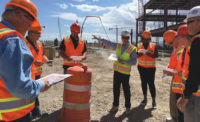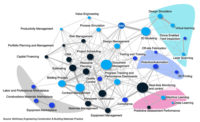Construction Technology
Bring Back the Two-Way Radio
The president of a family-owned 73-year-old construction firm wants to use two-way radios on jobsites again.
Communication technology today is, for the most part, amazing. But I say “for the most part” because it isn’t totally amazing.
During its evolution, technology has enabled—indeed forced us—to abandon powerful communication tools that were of great value for running successful construction companies. Those who have been around long enough to remember the era of two-way-radios know what I mean.
Before personal computers, cell phones, emails and texts, we used two-way radios for construction communications. Today’s technology is appropriate for personal communication, and I don’t want to denigrate its efficiency, but for construction, today’s tools don’t have anything like the powerful impact of two-way radios.
When we needed to spread the gospel of productivity, safety, quality and ethics, the two-way radio was far superior. That simple device, with the push of a button, was a microphone and a bullhorn connecting every employee in the company. Unlike the voice-activated technologies of today, it blared activated voices. This was important for two reasons:
A voice, when angry, amusing, complimentary or instructive is exponentially more expressive than a text or an email because it sets an unmistakable tone. When such a voice is in a public forum, it lends gravity to the issue because everyone in the company is listening. This elevates the concept of accountability and responsibility, which leads to credibility.
Much of what I learned early on in my career can be traced back to the exchanges I listened to on the radio. Car 1, Car 4 and Car 9, otherwise known as Raymond, Francis and George, could be heard daily spewing out orders and suggestions on everything from safety, to production, to equipment maintenance—sometimes with humor, sometimes with tutorial instruction and sometimes with the fury of Genghis Kahn.
Those public tongue-lashings served as baptisms into a corporate culture that was demanding, to-the-point, and bigger than the individual. They provided a sense of belonging that no email can begin to duplicate.
Sitting at South Main (Command Central), you could be an ear-witness, in real time, to all the crucial issues besetting every jobsite of every division. At the end of each shift, questions streamed over the airwaves. “How many tons, how many cubic yards, how many linear feet?” If production was down you would ultimately be asked, “What happened?” And God help you if you had no answer or the wrong answer. You always felt the pulse of the company and knew with certainty where your attention should be focused.
Political correctness was non-existent. Words and tones were chosen to send the message home. Outbursts like “You tell ‘that guy’ the next time I see him doing anything that stupid will be the last time!” served as strike one of a two-strike scenario in which every employee was at bat.
One classic exchange that sticks in my mind involved Car 1 and an employee who had a company pickup truck. Noticing that the truck was dirty, Car 1 told him to wash his vehicle. His response: “I washed it yesterday”. Car 1’s response: “Did you wash your face this morning?” The message was clear—the truck was the face of the company and should look clean every day.
Sometimes when atmospheric conditions permitted, we could hear the dialogue or diatribe of other companies overlapping our frequency. These too reminded us of how the competition viewed the world and what we needed to do to compete.
Our corporate culture has been hi-jacked by technology, making it harder to communicate with those actually doing the work. The best we can do, short of bringing back the radios, is to make a point of spending more time in the field, not the field office. Speak to the crews. Impart expectations. Listen to problems. You just might learn and share something that can benefit us all.
Over and out.



